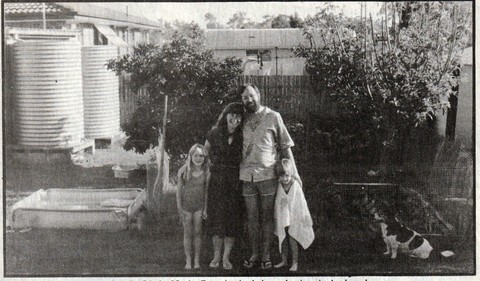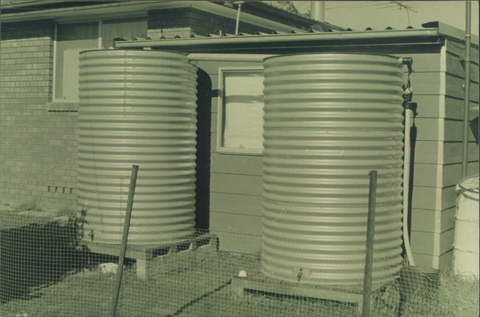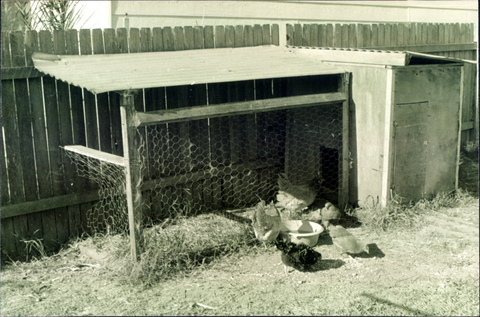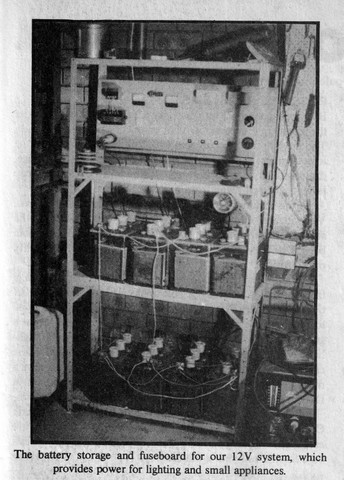I wrote this for Grass Roots Magazine and it was published in GR 71 (Feb 1989), just over 30 years ago. It provides a window into how far we had gotten on our journey at that stage.

Following Meg’s plea in ‘Gumnut Gossip’ (GR 69) for more contributions about urban efforts at achieving ‘the good life’, I decided a reply was in order. I hope my story is of some interest and, or inspiration to other readers.
In 1977 I took my newly acquired wife and heated for the wilds of St Clair, a new estate in outer Western Sydney. I had enthusiasm but little or no real knowledge of gardening (organic or otherwise) or most other self-sufficiency skills. Thus my first attempt at planting the wrong seeds, at the wrong time of year, direct into sun-baked clay was doomed from the start. This was pre Grass Roots for me after all!
I had read parts of a book by Michael Allaby titled ‘The Survival Handbook – Self-sufficiency for Everyone’. It was written for English conditions and not very applicable but I had found a conspicuous lack of home grown information on self-sufficiency. It was, however, an interesting book and motivated me to search farther afield.
I played at veggie gardening but not much else for several years until we were able to put a garage on the side of the house. All of a sudden, I had a workshop/storage area so I could finally do something! When the garage was built, a place was needed to accept the rain runoff from its gutter. The local council said “rubble drain”. I said “Oh No! My veggie patch! What about a rainwater tank?” The council said “What! Oh……OK”. So I put in a 2275 litre (500 gallon) tank followed a few years later by another one of the same size. I now had an independent water supply. The garage allowd me to start a project which I had in mind for a number of years – a 12 volt lighting system for the house.

One of the first things we bought for the house was an open fire. Ten years ago they weren’t so ‘trendy’ and wood was cheaper and easier to find. Now, unless you have a tame wood supply, wood burners aren’t necessarily an assistance to urban self-sufficiency. Wood is storable, true, but so is kero and you can fit a lot more ergs into a smaller space! We had also put on solar hot water when the wife left work with no1 (Angela). What we needed now was an independent electricity supply for lighting plus odd bits and pieces like radio and rechargeable torch. (for a more comprehensive discussion of the 12 v system see GR62 pp68 – 69). We now have a 12 volt lighting system with a light in most rooms of the house, the garage, back shed and over the wood pile, all driven by one photovoltaic panel and a battery bank. The 12 volt system took time, thought, effort and money, but to me all were well worth it. It is still evolving as better products and ways of doing things come up. A 12 volt generator/welder based on a petrol engine and car alternators is on the drawing board as is a home built wind generator. All these things take time and the quest for self-sufficiency never ends.


.jpg)
While all this high tech experimentation was going on, the veggie patch was improving too. With the discovery of mulching and composting my yields were improving with less work in weeding and watering. It was about this time that I decided a few fruit trees would be good; tow of the three originals (mandarin, peach and apple) are still alive and thriving. We currently have eight fruit trees in the back yard – two peaches, one apple (granny smith) one orange, one lemon, one lemonade (a new variety) one mandarin and a banana tree. Along the way I managed two lemons and a peach as well as the original apple, mostly through wet feet. I try to learn from my mistakes, so the rest will survive (I hope).
After I had been progressing well with the fruit trees, I decided it was time for another self-sufficiency quantum leap – to chooks! Due to council regulations, full size chooks are forbidden (shades of big brother!), but bantams are ‘cage birds’ and so OK. We have six at last count which free range over the back yard (except the veggie patch, of course!), supplying us with anything from one up to six eggs a day, all on leafy bits from the veggie patch, scraps and some imported (from outside the fence line) grain, especially in winter. Chooks are truly amazing, supplying eggs, fertiliser and entertainment as well as composting veggie scraps for us, and at minimum cost. No urban self-sufficiency person should be without them where possible.
Back to the veggie garden again, and things are still improving! For self-sufficient gardening two points worth investigating are growing your own seedlings and saving seeds from your own veggies. For starting seed early I built a mini plastic house which in summer doubles as a solar drier for produce. Placed on the north side of our house it will raise tomato, cucumber, zucchini seedlings etc. earlier so I can get a head start when spring comes. As for seeds, you can’t be self-sufficient if you dutifully go out every year to K-Mart for your seeds and seedlings. A booklet brought out by the Henry Doubleday Research Association called ‘Seed Production for the Australian Home Vegetable Gardener’ (Allen and Christina Barry, authors) is of great assistance here. I use as many of my own seeds as possible, but you must have non-hybrid seed to start with. Some biennial seeds are a bit difficult eg carrots, but leaving a couple of your best plants in over winter to flower next year can provide good quantities of seed.
With all the fruit and vegetable produce you can grow, preservation of the excess can be a problem. The aforementioned solar drier works well for me on some things but lately I have discovered the old Fowlers’ Vacola bottling outfit. Second hand they can be quite cheap to buy although new lids and rubber rings are invariably needed. I am still experimenting with mine – a few bottles of this or that to see what is agreeable to the family and what is not. Fruit done in the Vacola bottler is especially popular.
One project I have had in mind for years has been vetoed by my partner in self-sufficiency – bees. Apart from the obvious harvest of honey, tame bees can increase your fruit and vegetable production by increasing flower pollination. However, my wife said “what about the children?”, so that killed that. There is another point worth raising, that urban honey will tend to contain poison spray contamination from other people’s gardens, as well as good old pollution. Perhaps the lack of bees is for the best after all.

The one main asset which has enabled me to go as far as I have is the garage/workshop where I can make those bits and pieces, repair tools, fix the car and things that go wrong in the house. Being self-reliant for repairs requires tools and at least some spares as well as a place to work and store/organise your tools and spares. This is a side of self-sufficiency less glamourous and more work than veggie gardening or 12 volt power, but a well-equipped workshop can save you big dollars in repair costs and work you can do yourself when building greenhouses, solar driers, wind generators and the like.
The quest for self-sufficiency never ends, basically because you never quite achieve it. There are always new projects, ideas and systems to be tried or old ones to be improved or modified (I have had a herb garden in the pipeline for a couple of years – next year for sure!). When you have to work and look after a family time is precious but even in the urban area some independence form society is possible with a bit of time, some money, but more than anything else……perseverance. So don’t put off your veggie garden, chooks, 12 volt system or whatever until you ‘head for the bush’. Making your mistakes now while you still have support systems in place will be less costly and traumatic and will enable you to be that little bit better prepared when you do make the break. So go ahead, do it now.



